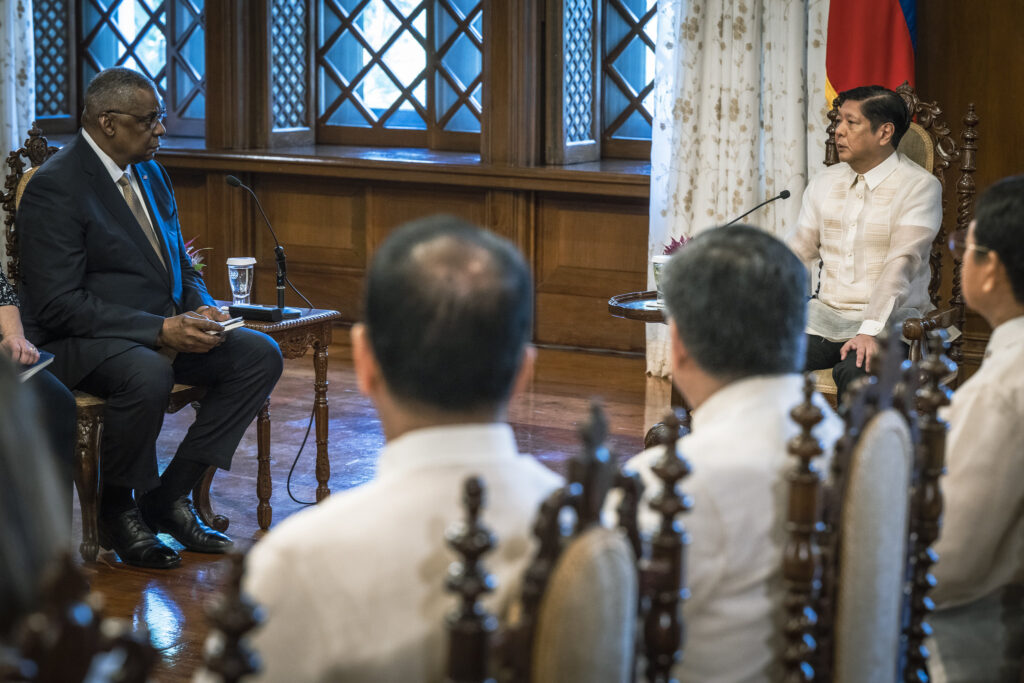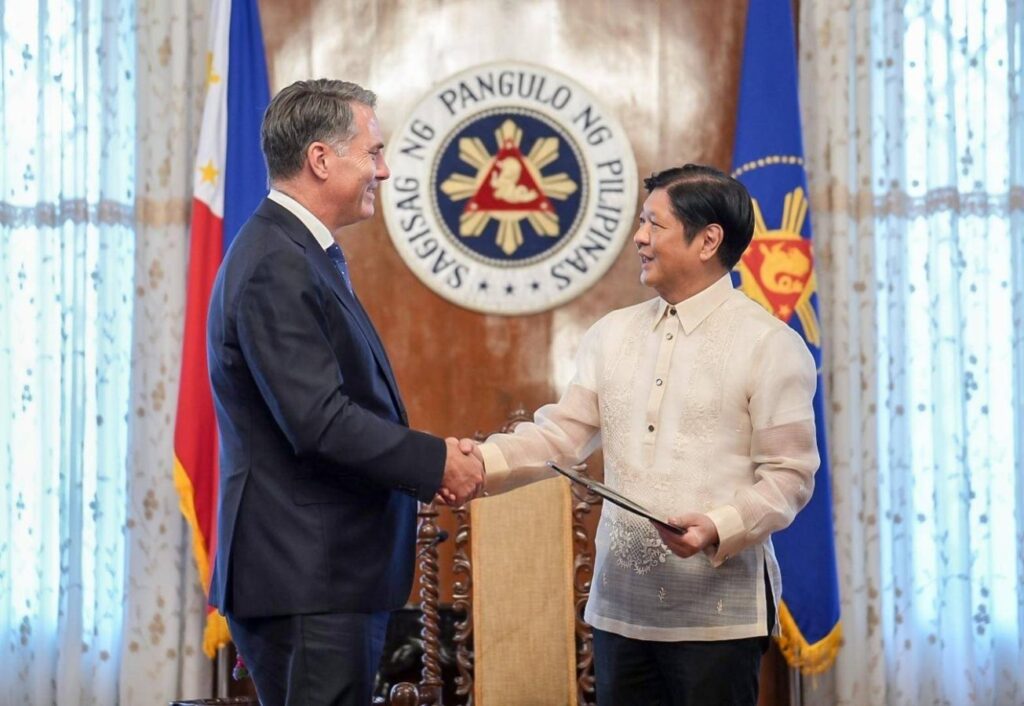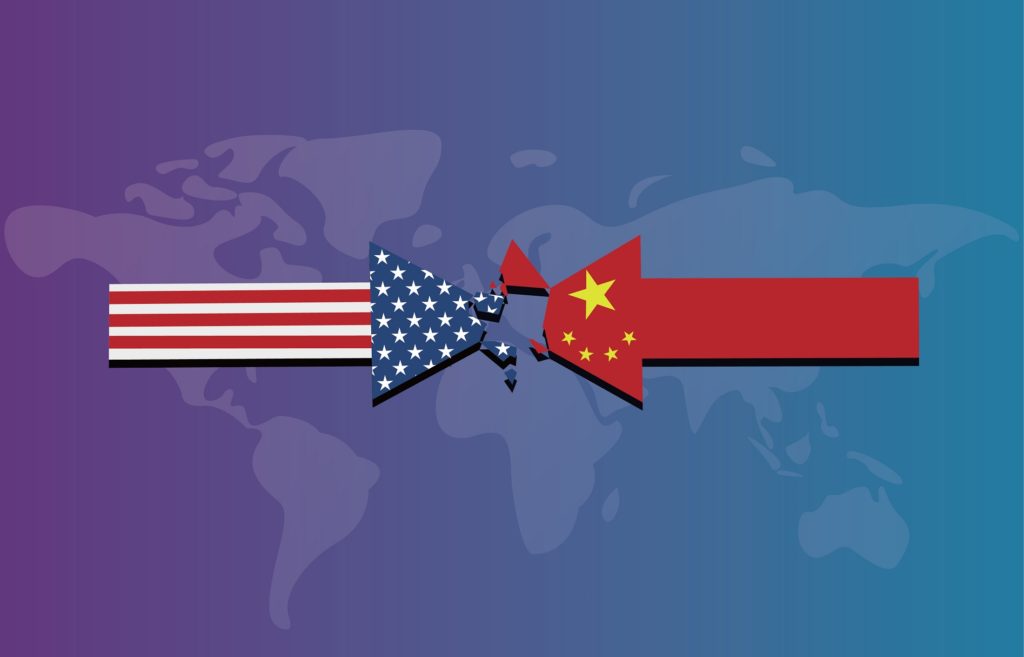New Philippine President Ferdinand Marcos Jr. (2nd R) raises his hand to take the oath as president during his inauguration ceremony at the National Museum in Manila on June 30, 2022. (Photo by JAM STA ROSA / AFP) (Photo by JAM STA ROSA/AFP via Getty Images)

Research Associate &
Manager, Maritime Affairs Program
Since President Ferdinand “Bongbong” Marcos Jr.’s inauguration in June 2022, the Philippines’ new administration appears to have been open and direct in its heavy encouragement of bilateral partnerships and emphasis on self-defense. Marcos Jr. is already working towards a clear, new vision for the Philippines in the wake of the preceding administration’s about-face reputation.
While Manila’s diplomatic moves—many of which have already strengthened Philippine-U.S. relations—may not significantly alter Philippine-China relations, they are already impacting U.S.-China bilateral relations.
Between years of built up suspicions and verbal battles, the health of the U.S.-China relationship may very well be at its ‘sourest’ point ever; a fact that may persist as the U.S. renews and enhances its security cooperation with one of China’s neighbors.
Although a foreign diplomatic plan already appears to be underway, the Marcos administration is still settling in. If ‘Step 1’ in Marcos’ plan is to reestablish trust in Manila on the global stage, then what is ‘Step 2’ and beyond? Regardless, the world can expect to continue to see Manila’s foreign ministry in action for months, if not years, to come.
Over the last few months, the Philippines has been particularly active in its diplomacy; especially with the United States. As President Ferdinand “Bongbong” Marcos Jr. was elected in May 2022 and inaugurated the following month, the next general election in the Philippines is not until 2028. Marcos Jr. has only just settled into his role as President and the leader of his executive administration. The Marcos administration also has yet to release an updated national security strategy, with the latest being released in 2018, and still needs to replace the “National Security Policy 2017-2022” that his predecessor President Rodrigo Duterte released in April 2017. Given the new nature of his presidency, this lack of formal release at this time is not surprising, as they require time to be properly developed and finalized.
What is somewhat surprising, however, is the frequency, breadth and nature of bilateral international relations interactions that the new Philippine administration has enacted in the months directly following inauguration, and how such patterns could give the world a sneak peak into Manila’s upcoming national strategy releases. At present, it appears the Marcos administration has a clear vision—potentially one centered around periodically affirming allies to ultimately ensure the self-preservation of its land and resources—and is already enacting its initial stages.
Both on the domestic and international fronts, Manila has been making a series of calculated policy adjustments over recent months that contribute towards the fine-tuning, clarification and calibration of Manila’s renewed public image. After half a decade of “eccentricities” and political “flip-flops” under the preceding President Rodrigo Duterte, the new Marcos administration likely has as priorities both the reestablishment of public trust and clarification of viewpoint—which tend to be most quickly achieved through strong, unambiguous changes, statements and open-armed gestures. Furthermore, the Marcos administration, headed by the son of a former Philippine dictator, is not afraid of letting people know these major changes are underway as such gestures are openly celebrated or remarked upon. Both domestically and internationally, Manila has been laying the foundations for such a policy since Marcos’ inauguration.

Much of the adjustments and clarifications thus far have been related to the self-preservation of the Philippines’ maritime realm; a fact that also suggests the prioritization of maritime affairs to the new administration of this island nation. For instance, on January 10, 2023, the Philippines’ Supreme Court voided the 2005 South China Sea energy exploration deal made with Chinese and Vietnamese firms, declaring them illegal on the grounds that the constitution “does not allow foreign entities to exploit natural resources.” The newly proposed domestic ‘Blue Economy Act’ alone, if passed, would bring a series of structural and focus changes to the Philippines. On the security front, the Philippine Coast Guard now more regularly comments on other countries’ naval vessels—namely, Chinese navy vessels—being spotted off their coasts. As recently as February, President Marcos himself has openly expressed “serious concern” over the East and South China Sea as part of a formal joint statement with Japanese Prime Minister Fumio Kishida. Then on March 8, the Philippine coast guard announced the launch of a strategy of publicizing aggressive actions by China in disputed areas of the South China Sea; perhaps inspired by Japan’s own public record-keeping tactics in the East China Sea.
There also appears to be an overarching trend in Manila of reaffirming warm, cooperative ties, both with the United States and with other partners. A mere few months after a full presidential transition, Manila began welcoming and encouraging in-person visits; likely a cornerstone tactic of Manila’s new foreign policy plan born from the country’s last decade of inconsistency.
To note a few interactions with the United States alone, on August 6, 2022, Secretary of State Antony Blinken met with President Marcos and Secretary of Foreign Affairs Enrique Manalo—with whom he previously and afterwards talked with on the phone—“to discuss bilateral efforts to strengthen the U.S.-Philippines alliance.” In this August 6 virtual meeting with Blinken, Manalo noted that “[w]e consider [two other U.S. congressional delegations visiting Manila over the next two weeks] a very positive sign of, I hope, the growing interest [of] United States legislators start off on the right foot with our new administration.” A few months later in mid-November, U.S. Vice President Kamala Harris visited Palawan; a Philippine island located near the disputed Spratly Islands on the edge of the South China Sea. Her visit was soon followed by White House press releases on Harris’ “New Initiatives to Strengthen U.S.-Philippines Alliance” and “Initiatives to Support U.S.-Philippines Maritime Cooperation.” While this uptick in in-person meetings could also simply be the result of lifted Covid-19 restrictions, bilateral engagements require intentional, dual allowance, if not encouragement, from both parties.
And it is not just political and military leaders who have been visiting the Philippines. Official U.S. government heads in the fields of counterterrorism, human rights, business and security have also had their attention on Manila. From January 19-20, 2023, the 10th Philippines-United States Bilateral Strategic Dialogue (BSD), described as “the main annual platform for our two countries to discuss the full range of political, security, and economic cooperation, exchange views on current challenges and strategic priorities, and identify new collaborative initiatives at the working group and senior officials’ levels,” was held in Manila. By its conclusion, the participants—including Assistant Secretary of State for East Asian and Pacific Affairs Daniel J. Kritenbrink—agreed to pursue cooperation in five areas, all of which either directly or indirectly indicate a strengthening, enduring bilateral bond.

The following month was also an active, progressive month for U.S.-Philippines relations, starting with U.S. Defense Secretary Lloyd Austin’s in-person visit to Manila “to affirm the unwavering alliance” between the U.S. and the Philippines. Less than one week later, Ambassador at Large for Cyberspace and Digital Policy Nathaniel C. Fick led a U.S. delegation to participate in the ASEAN Digital Ministers’ Meetings in Boracay, Philippines to not only “reaffirm” the U.S. partnership with ASEAN and commitment to the region, but also “explore opportunities for further cooperation.” On February 13, the U.S. Department of State released a press statement on “U.S. Support for the Philippines in the South China Sea” and made a press release “Marking One Year Since the Release of the Administration’s Indo-Pacific Strategy” which includes “four new Enhanced Defense Cooperation (EDCA) sites with the Philippines.” These announcements all took place just before U.S. representatives attended the Munich Security Conference and a G7 Leaders’ meeting, after which the Under Secretary of State for Political Affairs Victoria Nuland traveled to Manila. The changes over the past few weeks and months were sufficient enough for the U.S. Department of State to formally update their “U.S. Relations With the Philippines” bilateral relations fact sheet on February 23, 2023.
The U.S. was not the only relationship President Marcos’ new administration is looking to reestablish and reinforce. During the 2nd Philippines-Georgia Political Consultations on October 27, 2022, the governments of the Philippines and Georgia highlighted joint military cooperation by working on seafarers’ certification recognition. By the end of 2022 Manila had also signed a deal with India to boost maritime cooperation, heightened border security cooperation with Indonesia, and expressed support for the trilateral AUKUS alliance during a visit with Australian Ambassador to the Philippines Hae Kyong Yu.

Global engagements continued after the New Year. Canada is now looking to finalize and sign a defense memorandum of understanding with the Philippines by June 2023 in what the Canadian Embassy called “a new opportunity…[with] enormous potential and value.” In his own visit to Japan on February 10, Marcos Jr. signed a formal defense agreement in Tokyo with Japanese Prime Minister Fumio Kishida that will allow Japanese troops to join training exercises related to natural disasters and humanitarian projects. The agreement is seen as a positive step by the Philippines towards broader bilateral military cooperation, both with Japan and with other regional nations, and had been on the table since at least the previous November. It is also unique in that it would permit, under certain circumstances, Japanese military forces to be more than just an observer in the South China Sea region. Then, two weeks later the Philippines and Israel celebrated 65 years of friendship, commemorating and celebrating the various deals—“from a memorandum of understanding to initiate joint activities on trade and investment to a cooperation agreement in technological innovation, research, and development”—that had been signed in the last year alone.
Although Manila’s activities have been more focused on bilateral connections thus far, the Marcos administration has also been active at the multilateral level such as at the 2022 ASEAN Summit, held November 10-13 in Cambodia. Marcos Jr. was vocal at his first ASEAN Summit as president, where he openly pressed for the need for a regional ‘code of conduct’ in the South China Sea, among other issues. Top defense officials of the Philippines, Australia, and the United States are also in group discussions over establishing joint patrols in the South China Sea amidst “increasingly aggressive actions” by China in the disputed waters.
There are three important aspects to note about these signed agreements and memorandums of understanding—which are written and signed by two or more sets of human beings—in the general context of international relations.
First, while not necessarily legally binding, they do put a nation—that is, a nation’s reliability, soft power, and holistic reputation—at risk. By signing these pieces of paper, these nations’ representatives are putting the reputation of their nation at stake. This is especially true if the full contents of such agreements are revealed. If the contents of the agreement are not fulfilled, or are overshadowed, then their reputation is at high risk of diminishing. This is often why the contents of such agreements are written so vaguely, and why any that are highly detailed should be considered particularly important to pay attention to.
Second, such agreements are conversely opportunities for a nation to prove itself reliable on handling or progressing on a certain issue. This can be equally true for both larger, more traditionally powerful countries like the United States, and smaller, still developing nations like the Philippines. The level of intentional publicity given to the signing of agreements or diplomatic discussions is a sign of that nation looking to be seen as open-minded, reliable, and agreeable to work alongside. And, should a promise be involved, the successful and genuine fulfillment of that promise is instinctively interpreted as a long-term proof of reliability, or even an open invitation to trust.
Third, while there are no clear limitations on their duration, they are commonly designed for the long-term commitments of at least a decade, to give sufficient time for the parties to fulfill their deal. This inherently infers that the participating parties promise to positively interact on these issues at least for that time period.
This series of moves—which, again, have been readily advertised and celebrated—has already caught the attention of observers. Some have aptly noted that Marcos Jr. readily pulled away from China and Russia and “has adopted the most muscular foreign policy approach that the Philippines has seen in close to a decade.” This outlook is starkly different from the Philippines’ last six years under President Rodrigo Duerte, who was inaugurated in 2016 and soon after worked on ingratiating the Philippines to China. While Manila has not released a new formal national strategy yet, it is neither twiddling its thumbs or hiding its activities in the meantime. During the Pilipinas Conference in December 2022, Philippine Department of Transportation Secretary Jaime Bautista said that Manila is actively looking for opportunities to collaborate with other nations, explaining that the Philippines “aims to be a major maritime nation that values the safety and protection of marine life and marine environment.” Based on the consistent progression and open acknowledgement of these engagements in the first 10 months of his administration, President Marcos’ strategic policy likely has a strong basis on the need for restoring, identifying, forming and protecting allies.
Despite the series of stark changes, the new Marcos administration’s outspoken policy shifts and ‘open arms’ tactics may very well not transform China-Philippines relations; or even be much of a surprise to Beijing. As previously noted, the most recent administration in Manila built up a near notorious streak of being ‘wishy-washy’. So, China could very well have come to anticipate instability and sudden shifts in Philippine diplomacy. In some ways, the formal transition of power could have been more notice of change than China—and the rest of the world—has received for more than half a decade; a notice that could have easily led some in the Chinese cabinet to actively wait for such a formal re-establishment of Philippine relations with the U.S. and other nations.
While the two will naturally have disagreements—most pointedly and continuously on jurisdiction in the South China Sea—and verbal jousts might be exchanged over any apparent diplomatic favoritism, both China and the Philippines also acknowledge the persistent reality of being neighbors. Their trade and economic relations—a longstanding top issue for both nations—will not be interrupted by the Philippines’ recent diplomatic actions. Tourism especially will continue to be encouraged, especially with the lifting of China’s Covid-19 restrictions after three years. During a New Year’s meeting in Beijing, Chinese and Philippine presidents Xi Jinping and Ferdinand “Bongbong” Marcos Jr., respectively, called for “friendly consultation to appropriately resolve maritime issues.” They also discussed a communication agreement to “avoid miscalculation and miscommunication,” though both sides still defended their own maritime rights.
This is not to say that there will not be expressions of disapproval by Beijing over Manila’s diplomatic movements, as China has been increasingly known to make. For instance, coinciding with bilateral meetings between the Philippines and representatives of Japan and the United States in February 2023, both of which resulted in strengthened bilateral naval partnerships, a China Coast Guard vessel was reported harassing a Philippine Coast Guard vessel with lasers during a resupply mission off the coast of the Philippines—an action that led the Philippines to file a formal diplomatic protest. A month later, the Philippines reported a Chinese navy ship and dozens of militia vessels “slowly loitering” around Philippine-occupied (Pagasa) Thitu Island. Both China and the Philippines now have leaders at the helm who are not afraid of openly defending their national sovereignty from the other.
A relatively larger change brought by the Philippines’ uptick in diplomatic moves can be expected on a perimeter stage: U.S.-China bilateral relations. For at least half a decade, Beijing and Washington appear to have been creating and referencing lists of the others’ wrongdoings to freely use as ammunition; both subtly and explicitly. Between years of built up suspicions and verbal battles, observers are rightfully suspecting that U.S.-China relations are simultaneously brittle and hardened. At present, the health of the bilateral relationship may very well be at its ‘sourest’ point ever. Now, with the Philippines agreeing to provide the U.S. with access to four more domestic military bases (bringing the total of U.S.-accessible bases to nine), advertising the increased presence as“especially important as the People’s Republic of China continues to advance its illegitimate claims in the West Philippine Sea,” it is understandable for China to respond with warnings of heightened regional tensions and sharpened rhetoric.

With every month that passes, the rift in the U.S.-China relationship appears only to expand. In the last few years, U.S. representatives have lost virtually any shyness in listing China by name in association with negative, protectionist terminology; in annual trade reports, in bilateral conversations with other national representatives, in formal joint statements, in congressional legislations, in media interviews, and more. Beijing follows a similar, disturbing trend. In February 2023, just weeks after signs of potentially progressive bilateral talks, the Chinese Foreign Ministry published a 4,000-word piece titled “U.S. Hegemony and Its Perils.” This piece, which echoes many of Beijing’s own continual, unfriendly statements on the U.S. in its formal papers and interview statements, was described as a “catalogue of grievances that casts the United States as a hypocritical superpower, advancing its own self-interests…while leaving a trail of abuse and harm in its wake.”
While these facts do not paint a picture of the entirety of U.S.-China relations, they unfortunately reflect the majority trend of where the health of the bilateral relationship currently stands: poor in grade and hardened to proposals. Unfortunately, the Philippines’ political adjustments sprinkled on top of these facts are not improving the bilateral status or softening any minds. It is an unfortunate, and almost surely unintentional, consequence of Manila’s shift in political attitude as the Philippines finds itself dangerously and increasingly in the midst of U.S.-China tensions.
If the recent uptick in bilateral cooperation, agreements, and meetings are actually more of a transition than a shift, then what is Manila transitioning towards for Marcos Jr.’s remaining five years as president? There are several ways the world can interpret and summarize the Marcos administration’s recent actions.
Unlike some not-so-long-ago times, the Philippines government wants to create bilateral bonds and show that it is open for business. Not only does Manila want to establish diplomatic friendships, but with these recent actions it appears to be seeking some level of official, and likely long-term, partnerships. Domestically, the new Marcos administration either feels comfortable enough to take calculated risks in its international relations or is reaching a boiling point where it feels vulnerable and under pressure to clearly (and publicly) identify its partners. Since many of the major transitions are maritime or security-related, it is fair to infer that Manila is now focused on bolstering these fields. Each of these interpretations have their seeds of merit, though it is still too early in the Marcos administration to be sure which, if any, will blossom into fact as the years continue and circumstances change.
While the presidency may be young, it is neither filled with ignorance nor inexperience. President Marcos succeeded a national leader who was often depicted as provocative and violent. This series of global interactions and formal efforts could likely be the first step in correcting that simplified view and clarifying what the current Philippines—and the Philippines of the next seven years—will look like. President Marcos is likely in the process of establishing himself and his administration on the world stage; intentionally painting a new self-portrait for his country that has just been through a particularly rocky decade. If that is truly the case, then the world—including the United States and China—can expect to continue to see the Philippines’ foreign ministry in action for months, if not years, to come.

The Institute for China-America Studies is an independent nonprofit, nonpartisan research organization dedicated to strengthening the understanding of U.S.-China relations through expert analysis and practical policy solutions.
1919 M St. NW Suite 310,
Washington, DC 20036
icas@chinaus-icas.org
(202) 968-0595
© 2025 INSTITUTE FOR CHINA-AMERICA STUDIES. ALL RIGHTS RESERVED.
Diverging Currents: U.S.–China Strategies on Deep Seabed Mining and the Future of Ocean Governance